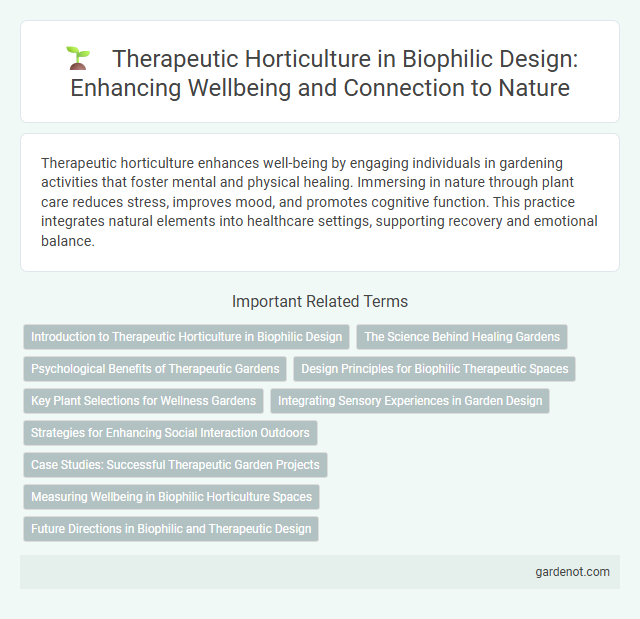Therapeutic horticulture enhances well-being by engaging individuals in gardening activities that foster mental and physical healing. Immersing in nature through plant care reduces stress, improves mood, and promotes cognitive function. This practice integrates natural elements into healthcare settings, supporting recovery and emotional balance.
Introduction to Therapeutic Horticulture in Biophilic Design
Therapeutic horticulture integrates plant-based activities into biophilic design to promote mental and physical well-being by fostering a connection to nature. This approach utilizes gardening tasks, sensory engagement with plants, and natural settings to reduce stress, enhance cognitive function, and support emotional healing. Incorporating therapeutic horticulture in built environments aligns with biophilic principles by embedding natural elements that boost occupant health and restorative experiences.
The Science Behind Healing Gardens
Therapeutic horticulture leverages the science behind healing gardens to promote physical and mental well-being by engaging individuals in plant-based activities that reduce stress and improve mood. Research from institutions such as the University of Michigan highlights how exposure to natural elements and gardening tasks stimulates neurochemical responses, enhancing cognitive function and emotional resilience. Healing gardens designed with biophilic principles create restorative environments that support recovery, aid pain management, and foster social interaction in healthcare settings.
Psychological Benefits of Therapeutic Gardens
Therapeutic horticulture in biophilic design promotes psychological well-being by reducing stress, anxiety, and depression through direct interaction with plants and nature. Exposure to therapeutic gardens enhances mood, cognitive function, and emotional resilience by fostering mindfulness and relaxation. Studies highlight significant improvements in mental health outcomes for individuals engaged in gardening activities within biophilic environments.
Design Principles for Biophilic Therapeutic Spaces
Therapeutic horticulture in biophilic design emphasizes integrating natural elements such as plants, water features, and natural light to promote physical and mental healing. Design principles prioritize sensory engagement, accessibility, and adaptability to support diverse user needs and therapeutic goals. Incorporating seasonal changes and biodiversity enhances restorative experiences and fosters a deeper connection to nature within therapeutic environments.
Key Plant Selections for Wellness Gardens
Therapeutic horticulture in wellness gardens emphasizes key plant selections such as lavender, known for its calming properties, and chamomile, which aids in stress reduction. Incorporating rosemary and eucalyptus supports cognitive function and respiratory health, while colorful blooms like marigolds and sunflowers enhance mood and visual stimulation. Focusing on native and sensory-rich plants ensures ecological compatibility and maximizes therapeutic benefits.
Integrating Sensory Experiences in Garden Design
Therapeutic horticulture leverages the integration of sensory experiences in garden design to enhance mental and physical well-being through engaging sight, touch, smell, sound, and taste. Incorporating diverse plant textures, fragrant herbs, colorful blooms, and water features creates a multi-sensory environment that stimulates cognitive function and reduces stress. Evidence from studies in healing gardens demonstrates that sensory-rich landscapes significantly improve mood, focus, and rehabilitation outcomes for users.
Strategies for Enhancing Social Interaction Outdoors
Therapeutic horticulture in biophilic design promotes social interaction through community gardens, interactive planting areas, and sensory-rich landscapes that encourage collaboration. Incorporating seating arrangements and accessible pathways facilitates group activities and inclusive engagement within outdoor spaces. These strategies enhance mental well-being by fostering social bonds and a sense of belonging in therapeutic environments.
Case Studies: Successful Therapeutic Garden Projects
Therapeutic horticulture projects such as the New York Botanical Garden's Edible Academy and the Royal Botanic Gardens' Wellbeing Garden demonstrate measurable improvements in mental health and cognitive function among participants. Studies published in the Journal of Therapeutic Horticulture report reduced stress levels and enhanced social interaction for individuals engaging with these green spaces. Case analyses indicate that integrating diverse plant species and accessible garden layouts maximizes the therapeutic benefits in clinical and community settings.
Measuring Wellbeing in Biophilic Horticulture Spaces
Measuring wellbeing in biophilic horticulture spaces involves assessing psychological and physiological indicators such as reduced stress levels, improved mood, and enhanced cognitive function. Quantitative data from biometric sensors and qualitative self-reports provide comprehensive insights into the therapeutic effects of plant interaction and natural environments. Integrating these metrics helps optimize biophilic design strategies to maximize mental health benefits and promote holistic healing.
Future Directions in Biophilic and Therapeutic Design
Therapeutic horticulture is poised to integrate advanced biophilic design principles that enhance sensory engagement and promote psychological well-being through immersive natural environments. Future directions emphasize the use of smart technology to customize plant care and environmental conditions, fostering adaptive healing spaces tailored to individual needs. Emerging research highlights the potential of biophilic interventions to reduce stress and improve recovery outcomes in healthcare and urban settings.
Therapeutic horticulture Infographic

 gardenot.com
gardenot.com